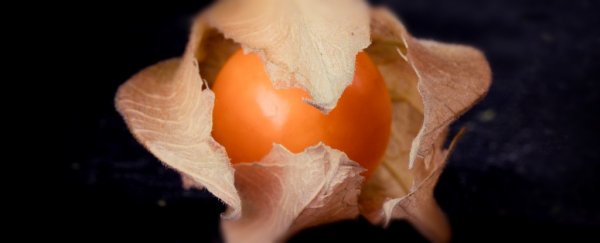The name is not appetising: it's called the groundcherry. It's possible you haven't heard of this fruit, but with some genetic tweaks, it could become a supermarket staple sooner than you think.
That's because scientists have used the groundcherry as an experimental test case to illustrate just how quickly CRISPR genome editing can speed up the domestication of wild, unruly plants.
For a relatively obscure crop like the groundcherry (Physalis pruinosa) – aka 'husk cherries' and native to Central and South America – it would have been a long, hard road to acceptance within mainstream agriculture without the helping hand of scientists.
That's because it's difficult to grow, and its fruit sporadically drops to the ground from the vine, often before it's ripe, making it difficult to farm on a large scale.
To tame these shortcomings via traditional plant domestication – shrewdly developing its desirable traits over successive generations and seasons – would take decades, centuries, or even longer.
Things tend to move a bit faster with CRISPR. In a new study, researchers have demonstrated that the same domestication process can take place in only a few years, thanks to the incredible control afforded by precise genetic editing.
"I firmly believe that with the right approach, the groundcherry could become a major berry crop," says lead researcher and plant scientist Zachary Lippman from Cold Spring Harbor Laboratory.
"I think we're now at a place where the technology allows us to reach."
Together with researchers at the Howard Hughes Medical Institute and the Boyce Thompson Institute, Lippman sequenced some of the groundcherry's genome and used CRISPR to manipulate its genes.
Doing so gave the ability to influence a hormone that regulates flowering, encouraging the plant to become more compact and producing fruit in clusters rather than individually.
Another tweak made the fruit themselves denser, while a third modification boosted the overall size of the fruit, by increasing its number of seeded sections.
"This is pretty good proof that with gene editing you can think about bringing other wild plants or orphan crops into agricultural production," Lippman says.
"The more arrows we have in our quiver to address agricultural needs in the future, the better off we're going to be."
For the purposes of the current study, that's as far as the team went, but the researchers aren't finished with the groundcherry yet.
Next, the team is looking at how to modify the fruit's flavour and colour. Today's groundcherry tastes both tropical and sour, with hints of vanilla, and an "intoxicating" smell. Quite where scientists might take it in the years to come is anybody's guess, however.
To manipulate the groundcherry, the researchers relied upon what scientists already knew about the tomato genome, and the genes and mutation that control how its fruit grows.
The thinking is, as this kind of science develops, researchers' ability to control custom-designed crops and fast-track them toward mass levels of agricultural production could change the way humans grow and eat food.
"We targeted genes that we knew from our experience could make the plant more compact and manageable," one of the team, Joyce Van Eck from the Boyce Thompson Institute, told CNN.
"Farmers have been saying, 'if you can just get them to behave, we'd be growing acres of these.'"
The findings are reported in Nature Plants.
A version of this article was first published in October 2018.
